Please
click on the photos at left (as applicable) to jump to large-scale copies
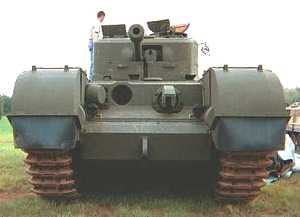 |
The
business end of a late model Mk.VII Churchill Crocodile flame tank. These
were converted from standard Mk.VII infantry tanks in time for Normandy.
The Churchill in whatever guise is a formidable beast which performed a
unique role in British service, and supported British and Canadian infantry
formations ably throughout the conflict in Northwest Europe. Canadians
themselves used a much earlier version at Dieppe before re-equipping with
Shermans.
In this
picture, note the driver's vision block is open and note the normal BESA
machine gun has been supplanted by the flame gun. |
|
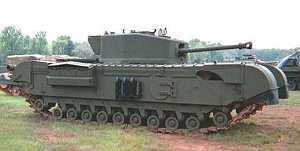 |
The
profile of the Churchill gives some indication of its size. From this angle,
this Crocodile is identical to the standard Mk.VII infantry tank, which
was the version most common in the latter part of the war. Sporting a 75mm
QF main gun, 152mm frontal armour and excellent tractability, the Churchill
could absorb punishment which frequently rendered Shermans hors-de-combat,
as well as traverse ground which would bog the smaller American tank. |
|
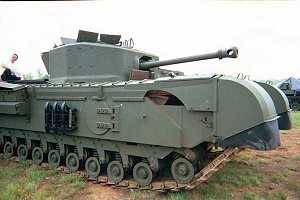 |
A
closer profile shot gives some indication of the brute size of the Churchill.
Frequently the mud guards over the front horns were removed, usually by
choice and if not by collision or enemy action. With it's unique design
of having its massive steel tracking up front, the Churchill could climb
or batter through obstacles which would stall the Sherman. Note the round
escape hatch for the driver, just forward of the spare track links. |
|
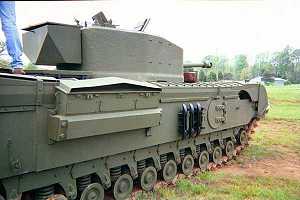 |
Looking
forward from right rear gives some indication of the length of the beast.
Having many small road wheels permitted the tank to function even if some
were destroyed by enemy fire. The top speed for the 40 ton Churchill was
approximately 12 mph, driven by a Bedford 12 cylinder power pack of 350
hp. This tank was designed as an infantry support vehicle where speed was
not an issue. For more on Churchill specifications and development history,
please see Claus Bonnesen's superb site ON
ARMOUR. |
|
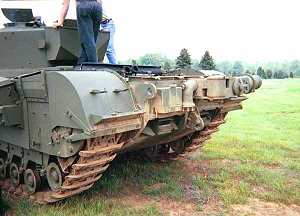 |
Left
rear view shows details of the still intact hook-up for the Crocodile armoured
trailer, which contained the fuel and propellant. The quintessential reference
for both the Churchill in general and the Croc in particular is FLAMETHROWER,
by Andrew Wilson. Written shortly after the
war by a former Croc tank commander, the book is a first-hand, sobering
peek into life in Churchills in the Northwest Europe campaign. It's out
of print now, but still available through the used book market; see our
BIBLIOGRAPHY
page for details on how to search for a copy. |
|
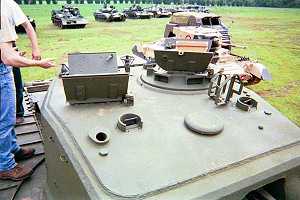 |
Turret
detail on the Mk.VII Churchill. Earlier turrets were one-piece cast, while
this was of both cast and welded construction. The hole in the left foreground
is the smoke discharger outlet (see next page for the other end). The two
horseshoe-shaped protuberances are vision ports. With two turret hatches,
escape for the three crew in the turret was much easier than in the normal
Sherman. Wilson indicates too that the Churchill was much less prone to
immediate fire upon being hit, compared to the Sherman. |
|
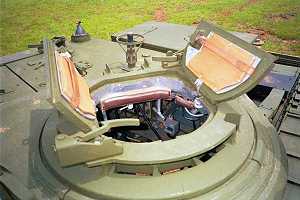 |
The
commander's cupola, showing the padded clamshell hatch covers and the vision
blocks. Visible to the rear and rear left are the two antenna brackets
for the standard No.19 wireless set mounted in the turret bustle. |
|
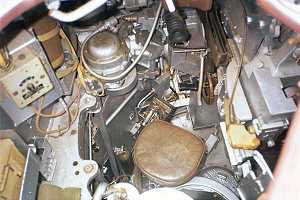 |
Looking
in through the commander's hatch, we see the gunner's seat immediately
below and forward. On the right is the breech for the 75mm QF (Quick Firing)
cannon, a British adaptation of the U.S. M3 75mm mounted in the Sherman.
To the left of the breech is a BESA 7.92mm machine gun, and to the left
of that, the sight for the main gun. On the far left is the control box
for radio and intercom, controlled by the tank commander. Surprisingly,
for its size, there isn't a lot of room in the Churchill's turret. |
|
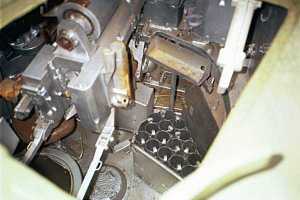 |
At
top, the loader's station, looking forward through his hatch. The main
gun is at left, and ammunition storage bottom centre.
Originally
designed in 1941, the Churchill was initially equipped with the standard
British 2pdr AT gun. Later this was upgraded to the excellent 6pdr (57mm),
which was a superb AT gun with its APDS round, but lacked an effective
high explosive round. Hence, the 75mm QF gun, which was rather the opposite.
British doctrine favoured fighting tanks with wheeled antitank guns rather
than other tanks, which were supposed to support the infantry in the advance.
This
was to change rapidly based on experiences in Italy and Normandy, but unfortunately,
the effective 17 pdr AT gun could not be fitted to the Churchill
and was instead adapted to the Sherman (Firefly version).
The bottom
picture shows the view forward from the gunner's seat. Centre frame is
the gunner's headrest and below that, the main gun sight. Immediately to
the right is the BESA machine gun. |
|
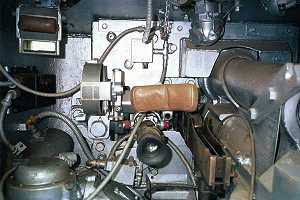 |
|
|
For
more Churchill interior views, please click here!
|
|
 12 Feb 00
12 Feb 00 |
Back
to Canadian Armoured Corps |
|
Back
to Vehicles |
|
Back
to Valentine |
|
| Copyright ©
Geoff
Winnington-Ball , 1999 - All Rights Reserved |
|